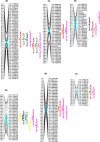Utilization of a Wheat55K SNP Array for Mapping of Major QTL for Temporal Expression of the Tiller Number
- PMID: 29599793
- PMCID: PMC5862827
- DOI: 10.3389/fpls.2018.00333
Utilization of a Wheat55K SNP Array for Mapping of Major QTL for Temporal Expression of the Tiller Number
Abstract
Maximum tiller number and productive tiller number are important traits for wheat grain yield, but research involving the temporal expression of tiller number at different quantitative trait loci (QTL) levels is limited. In the present study, a population set of 371 recombined inbred lines derived from a cross between Chuan-Nong18 and T1208 was used to construct a high-density genetic map using a Wheat55K SNP Array and to perform dynamic QTL analysis of the tiller number at four growth stages. A high-density genetic map containing 11,583 SNP markers and 59 SSR markers that spanned 4,513.95 cM and was distributed across 21 wheat chromosomes was constructed. A total of 28 single environmental QTL were identified in the recombined inbred lines population, and among these, seven QTL were stable and used for multi-environmental and dynamic analysis. These QTL were mapped to chromosomes 2D, 4A, 4D, 5A, 5D, and 7D, respectively. Each QTL explained 1.63-21.22% of the observed phenotypic variation, with an additive effect from -20.51 to 11.59. Dynamic analysis showed that cqTN-2D.2 can be detected at four growth stages of tillering, explaining 4.92-17.16% of the observed phenotypic variations and spanning 13.71 Mb (AX-109283238-AX-110544009: 82189047-95895626) according to the physical location of the flanking markers. The effects of the stable QTL were validated in the recombined inbred lines population, and the beneficial alleles could be utilized in future marker-assisted selection. Several candidate genes for MTN and PTN were predicted. The results provide a better understanding of the QTL selectively expressing the control of tiller number and will facilitate future map-based cloning. 9.17% SNP markers showed best hits to the Chinese Spring contigs. It was indicated that Wheat55K Array was efficient and valid to construct a high-density wheat genetic map.
Keywords: QTL; Triticum aestivum L.; Wheat55K SNP Array; genetic mapping; tiller number.
Figures


References
-
- Alam M. M., Mace E. S., van Oosterom E. J., Cruickshank A., Hunt C. H., Hammer G. L., et al. (2014). QTL analysis in multiple sorghum populations facilitates the dissection of the genetic and physiological control of tillering. Theor. Appl. Genet. 127 2253–2266. 10.1007/s00122-014-2377-9 - DOI - PubMed
-
- Allen A. M., Winfield M. O., Burridge A. J., Downie R. C., Benbow H. R., Barker G. L., et al. (2017). Characterization of a Wheat Breeders’ Array suitable for high-throughput SNP genotyping of global accessions of hexaploid bread wheat (Triticum aestivum). Plant Biotechnol. J. 15 390–401. 10.1111/pbi.12635 - DOI - PMC - PubMed
-
- Cavanagh C. R., Chao S., Wang S., Huang B. E., Stephen S., Kiani S., et al. (2013). Genome-wide comparative diversity uncovers multiple targets of selection for improvement in hexaploid wheat landraces and cultivars. Proc. Natl. Acad. Sci. U.S.A. 110 8057–8062. 10.1073/pnas.1217133110 - DOI - PMC - PubMed
-
- Cui F., Ding A., Li J., Zhao C., Wang L., Wang X., et al. (2011). QTL detection of seven spike-related traits and their genetic correlations in wheat using two related RIL populations. Euphytica 186 177–192. 10.1007/s10681-011-0550-7 - DOI
LinkOut - more resources
Full Text Sources
Other Literature Sources
Miscellaneous

